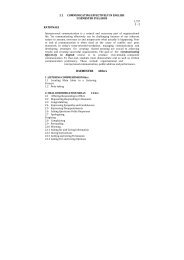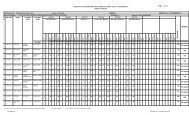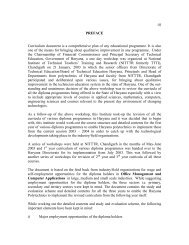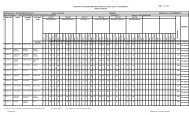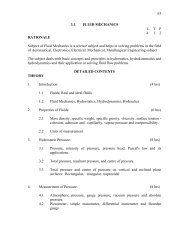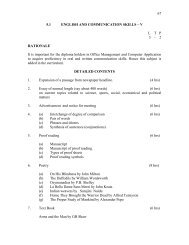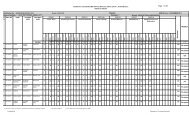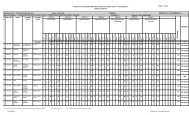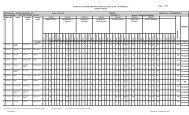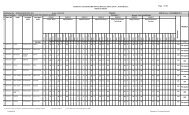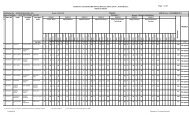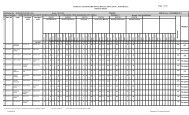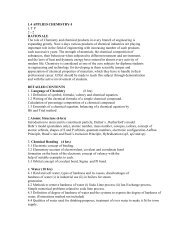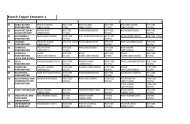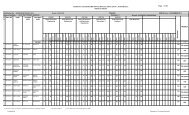61 3.1 STRENGTH OF MATERIALS L T P 3 1 2 RATIONALE Diploma
61 3.1 STRENGTH OF MATERIALS L T P 3 1 2 RATIONALE Diploma
61 3.1 STRENGTH OF MATERIALS L T P 3 1 2 RATIONALE Diploma
You also want an ePaper? Increase the reach of your titles
YUMPU automatically turns print PDFs into web optimized ePapers that Google loves.
<strong>61</strong><br />
<strong>RATIONALE</strong><br />
<strong>3.1</strong> <strong>STRENGTH</strong> <strong>OF</strong> <strong>MATERIALS</strong><br />
L T P<br />
3 1 2<br />
<strong>Diploma</strong> holders in this course are required to analyse reasons for failure of different<br />
components and select the required materials for different applications. For this purpose,<br />
it is essential to teach them concepts, principles, applications and practices covering<br />
stress, strain, bending moment, shearing force, shafts, columns and springs. Hence this<br />
subject has been introduced. It is expected that efforts will be made to provide<br />
appropriate learning experiences in the use of basic principles to the solution of applied<br />
problems to develop the required competencies.<br />
DETAILED CONTENTS<br />
1. Stresses and Strains (6 hrs)<br />
- Concept of load, stresses and strain<br />
- Tensile, compressive and shear stresses and strains<br />
- Concept of elasticity, elastic limit and limit of proportionality<br />
- Hooke’s Law, Young’s Modulus of elasticity, Yield point, plastic stage, Strain<br />
hardening, Stress strain diagram, Ultimate strength and breaking stress,<br />
Percentage elongation, Principle of superposition, Free body diagram, Proof<br />
stress and working stress, Factor of safety, Bars of varying cross-section,<br />
Temperature stresses and strains, Composite sections under compression and<br />
tension, Lateral strain, Poisson’s ratio, Numerical Problems.<br />
2. Resilience and Instantaneous Stress (5 hrs)<br />
- Concept of resilience, proof resilience and co-efficient of resilience<br />
- Modes of loading: gradual loading, sudden loading and falling load<br />
- Calculation of instantaneous stress induced due to gradual loading, sudden<br />
load and falling loads<br />
- Numerical problems on the above<br />
3. Beams and Bending Stress (8 hrs)<br />
- Concept of beams<br />
- Types of beams<br />
- Types of loading<br />
- Concept of end supports – Roller, hinged and fixed<br />
- Concept of bending moment and shearing force<br />
- Bending moment and shearing force diagram for cantilever and simply<br />
supported beams with and without overhang subjected to concentrated and<br />
UDL. Point of contraflexure.<br />
- Numerical problems
62<br />
4. Moment of Inertia (6 hrs)<br />
- Concept<br />
- Second moment of area<br />
- Radius of gyration<br />
- Theorem of parallel axes<br />
- Theorem of perpendicular axes<br />
- Section modulus<br />
- Moment of inertia of plane figures such as rectangle, square, triangle, circle,<br />
trapezium (without proof)<br />
- Numerical problems on: Angle section, T section, I section, circular section,<br />
channel section, Z section, hollow section and removed section<br />
5. Bending Stress (7 hrs)<br />
- Concept of bending stresses<br />
- Theory of simple bending, assumptions made in bending theory<br />
- Use of equation σ/y=M/I=E/R<br />
- Concept of moment of resistance<br />
- Bending stress diagram<br />
- Calculation of maximum bending stress in beams of rectangular, I and T<br />
sections<br />
- Permissible bending stress, section modulus for rectangular, circular and<br />
symmetrical I sections<br />
6. Springs (4 hrs)<br />
- Determination of number of plates<br />
- Maximum bending stress and deflection<br />
- Closed coil helical spring subjected to axial load<br />
- Stress deformation<br />
- Stiffness and angle of twist and strain energy<br />
- Falling loads on springs<br />
- Numerical problems<br />
7. Columns (5 hrs)<br />
- Concept of column, modes of failure<br />
- Types of columns<br />
- Buckling load, crushing load<br />
- Slenderness ratio<br />
- Factors effecting strength of a column<br />
- End restraints<br />
- Effective length<br />
- Strength of column by Euler Formula without derivation<br />
- Rankine Gourdan formula (without derivation)
63<br />
- Numerical problems<br />
8. Torsion (7 hrs)<br />
- Concept of torsion, difference between torque and torsion<br />
- Derivation and use of torque equation<br />
- Shear stress diagram for solid and hollow circular shaft<br />
- Comparison between solid and hollow shaft with regard to their strength and<br />
weight<br />
- Power transmitted by shaft<br />
- Concept of mean and maximum torque<br />
- Numerical problems<br />
LIST <strong>OF</strong> PRACTICALS<br />
1. Tensile test on bars of mild steel and aluminum<br />
2. Shear test on specimen of two different metals<br />
3. Impact test on metals (a) Izod test (b) Charpy test<br />
4. Torsion test on specimens of different metals for determining the angle of twist for<br />
a given torque<br />
5. To determine the stiffness of a helical spring and to plot a graph between load and<br />
extension<br />
6. Hardness test on metal and finding the Rockwell hardness<br />
RECOMMENDED BOOKS<br />
1. Strength of Materials by R.S. Khurmi; S. Chand and Company, Delhi.<br />
2. Strength of Materials by DR Malhotra, Satya Prakashan, Delhi.<br />
3. Strength of Materials by RK Rajput, SK Kataria and Sons, Delhi<br />
4. Strength of Materials by Birender Singh.<br />
5. Strength of Materials by Dr. Sadhu Singh.
64<br />
3.2 THERMODYNAMICS<br />
L T P<br />
3 1 2<br />
<strong>RATIONALE</strong><br />
A diploma holder in Mechanical Engineering is supposed to maintain steam generators,<br />
turbines and other power plant equipment. In addition he is required to maintain various<br />
types of automobiles. Therefore, it is essential to teach him concepts, principles and<br />
applications of basic thermodynamics, steam generators, steam turbine and other power<br />
plant equipment; non-conventional energy sources and about IC engines. Hence this<br />
subject.<br />
DETAILED CONTENTS<br />
1. Fundamental Concepts (4 hrs)<br />
Thermodynamic state and system, boundary, surrounding, universe,<br />
thermodynamic systems – closed, open, isolated, adiabatic, homogeneous and<br />
heterogeneous, macroscopic and microscopic, properties of system – intensive<br />
and extensive, thermodynamic equilibrium, quasi – static process, reversible and<br />
irreversible processes, Zeroth law of thermodynamics, definition of properties like<br />
pressure, volume, temperature, enthalpy, internal energy<br />
2. Laws of Perfect Gases (4 hrs)<br />
Definition of gases, explanation of perfect gas laws – Boyle’s law, Charle’s law,<br />
Avagadro’s law, Regnault’s law, Universal gas constant, Characteristic gas<br />
constants, derivation<br />
Specific heat at constant pressure, specific heat at constant volume of gas,<br />
derivation of an expression for specific heats with characteristics, simple<br />
problems on gas equation<br />
3. Thermodynamic Processes of Gases (4 hrs)<br />
Types of thermodynamic processes – isochoric, isobaric, isothermal, hyperbolic,<br />
isentropic, polytropic and throttling processes, equations representing the<br />
processes<br />
Derivation of work done, change in internal energy, change in entropy, rate of<br />
heat transfer for the above processes
65<br />
4. Laws of Thermodynamics (6 hrs)<br />
Laws of conservation of energy, first law of thermodynamics (Joule’s<br />
experiment), Application of first law of thermodynamics to non-flow systems –<br />
Constant volume, constant pressure, Adiabatic and polytropic processes, steady<br />
flow energy equation, Application of steady flow energy to equation, turbines,<br />
pump, boilers, compressors, nozzles, evaporators, limitations<br />
Heat source and heat sinks, statement to second laws of thermodynamics; Kelvin<br />
Planck’s statement, Classius statement, equivalence of statements, Perpetual<br />
motion Machine of first kind, second kind, (PMM1, PMM2), Carnot engine,<br />
Introduction of third law of thermodynamics, concept of irreversibility, entropy<br />
5. Steam Boiler (4 hrs)<br />
Water and fire tube boilers, construction and working of lancashire, babcock and<br />
Wilcox boilers. Various mounting and accessories of boilers.<br />
6. Ideal and Real Gases (4 hrs)<br />
Concept of ideal gas, enthalpy and specific heat capacities of an ideal gas, P – V –<br />
T surface of an ideal gas, triple point, real gases, Vander-Wall’s equation,<br />
Amagat’s experiment, equation of states<br />
Mass fraction, mole fraction, partial pressure, introduction to compressibility of<br />
gases<br />
7. Properties of Steam (4 hrs)<br />
Formation of steam and related terms, thermodynamics properties of steam, steam<br />
tables, internal latent heat, internal energy of stream, entropy of water, entropy of<br />
steam, T- S diagrams, Mollier diagram (H – S Chart), Expansion of steam,<br />
Hyperbolic, reversible adiabatic and throttling processes<br />
Quality of steam (dryness fraction), measurement of dryness fraction, throttling<br />
calorimeter, separating and throttling calorimeter<br />
8. Fuels and Combustion (8 hrs)<br />
Definition of fuel, types – solid, liquid and gaseous fuels, examples, uses of<br />
different types of fuels<br />
Calorific values of fuels, Dulong’s formula for calorific value, calculation of<br />
calorific values, chemical composition of a fuel
66<br />
Bomb calorimeter unit – description, procedure for determination of C.V. of solid<br />
or liquid fuel using bomb calorimeters, calculation of CV with test data<br />
Junker’s gas calorimeter unit – description, determination of gas using Junker’s<br />
calorimeter, Problems on CV determination with Junker’s calorimeter test data<br />
Balance chemical equations for the combination of C, H, S, CH 4 , and ethane<br />
Calculation of minimum air requirement for the complete combustion of unit<br />
mass/unit volume of fuel having a given composition, Conversion of volumetric<br />
analysis to gravimetric analysis and vice versa, calculation of percentage<br />
composition (by weight and volume) of fuel gas. Calculation of weight of fuel<br />
gases obtained by combustion of fuel with and without excess air, simple<br />
problems<br />
Description of Orsat apparatus and use, procedure for determination of flue gas<br />
analysis, chemicals used for absorption of different gases in flue gases<br />
Description and working of a mechanical type of CO 2 recorder.<br />
9. Air Standard Cycles (4 hrs)<br />
Meaning of air standard cycle – its use, condition of reversibility of a cycle<br />
Description of Carnot cycle, Otto cycle, Diesel cycle, simple problems on<br />
efficiency, calculation for different cycles<br />
Comparison of Otto, Diesel cycles for same compression ratio or same peak<br />
pressure developed<br />
Reasons for highest efficiency of Carnot cycle and all other cycles working<br />
between same temperature limits<br />
10. Air Compressors (4 hrs)<br />
Functions of air compressor – uses of compressed air, type of air compressors<br />
Single stage reciprocating air compressor, its construction and working,<br />
representation of processes involved on P – V diagram.<br />
Multistage compressors – advantages over single stage compressors, use of air<br />
cooler – condition of minimum work in two stage compressor (without proof),<br />
simple problems
67<br />
Rotary compressors – types, descriptive treatment of centrifugal compressor, axial<br />
flow compressor, vane type compressor<br />
11. Introduction to Heat Transfer (2 hrs)<br />
Modes of heat transfer, Fourier’s law, steady state conduction, composite<br />
structures, Natural and forced convection, thermal radiation<br />
LIST <strong>OF</strong> PRACTICALS<br />
1. To find out the dryness fraction of steam by throttling calorimeter.<br />
2. Determination of calorific value of fuel by bomb calorimeter.<br />
3. To find out specific fuel consumption by gravimetric or volumetric fuel<br />
equipment.<br />
4. To find out the viscosity index of lubricant by Orsat Apparatus.<br />
5. To find out CO 2 value of exhaust from engine by CO 2 recorder (Smokemeter).<br />
6. To study the construction and working of single stage air compressor.<br />
7. To find out the flash point of fuel by flash point apparatus.<br />
8. Study of various fire tube and water tube boiler by models or by visits.<br />
9. Study of various mounting and accessories of boilers.<br />
RECOMMENDED BOOKS<br />
1. Engineering Thermodynamics by PK Nag; Tata McGraw Hill, Delhi<br />
2. Basic Engineering Thermodynamics by Roy Chaudhary; Tata McGraw Hill,<br />
Delhi<br />
3. Basic Thermodynamics by PB Joshi and US Tumne; Pune Vidyarthi Grah<br />
Prakashan<br />
4. Engineering Thermodynamics by CP Arora; Tata McGraw Hill, Delhi<br />
5. A Treatise on Heat Engineering by VP Vasandani and DS Kumar; Metropolitan<br />
Book Company.
68<br />
3.3 BASICS <strong>OF</strong> ELECTRICAL AND ELECTRONICS ENGINEERING<br />
<strong>RATIONALE</strong><br />
L T P<br />
3 - 2<br />
The objective of the course is to impart basic knowledge and skills regarding electrical<br />
engineering, which diploma holders will come across in their professional life<br />
DETAILED CONTENTS<br />
1. Application and Advantage of Electricity (4 hrs)<br />
Difference between AC and DC, various applications of electricity, advantages of<br />
electrical enginergy over other types of energy<br />
2. Basic Quantities of Electricity (4 hrs)<br />
Definition of voltages, current, power and energy with their units, name of<br />
instruments used for measuring above quantities, connection of these instruments<br />
in an electric circuit<br />
3. Electromagnetic Induction (4 hrs)<br />
Production of e.m.f., idea of a transformer and its working principle<br />
4. Distribution System (8 hrs)<br />
Difference between high and low voltage distribution system, identification of<br />
three-phase wire, neutral wires and earth wire in a low voltage distribution<br />
system. Identification of voltages between phases and between one phase and<br />
neutral. Difference between three-phase and single-phase supply<br />
5. Domestic Installation (7 hrs)<br />
Distinction between light and fan circuits and single phase power circuit, subcircuits,<br />
various accessories and parts of electrical installation. Identification of<br />
wiring systems. Common safety measures and earthing<br />
6. Electric Motor (9 hrs)<br />
Definition and various applications of single-phase and three-phase motors.<br />
Connection and starting of three-phase induction motors by star-delta starter.<br />
Changing direction of rotation of a given 3 phase induction motor
69<br />
7. Electrical Safety (5 hrs)<br />
Electrical shock and precautions against shock, treatment of electric shock,<br />
concept of fuses and their classification, selection and application, concept of<br />
earthing and various types of earthing, applications of MCBs and ELCBs<br />
8. Basic Electronics (7 hrs)<br />
Basic idea of semiconductors – P and N type; diodes, zener diodes and their<br />
applications, transistor – PNP and NPN, their characteristics and uses,<br />
characteristics and application of a thyristor, characteristics and applications of<br />
servo motors.<br />
LIST <strong>OF</strong> PRACTICALS<br />
1. Connection of a three-phase motor and starter with fuses and reversing of<br />
direction of rotation<br />
2. Connection of a single-phase induction motor with supply and reversing of its<br />
direction of rotation<br />
3. Charging of a lead – acid battery<br />
4. Troubleshooting in domestic wiring system<br />
5. Connection and reading of an electric energy meter<br />
6. Study of a distribution board for domestic installation<br />
7. Use of ammeter, voltmeter, wattmeter, energy meter and multi-meter<br />
8. Ohm’s Law verification<br />
9. Verification of law of resistance in series<br />
10. Verification of law of resistance in parallel<br />
11. Study of different types of fuses<br />
12. Study of earthing pratices
70<br />
RECOMMENDED BOOKS<br />
1. Basic Electrical Engineering by PS Dhongal; Tata McGraw Hill Publishers, New<br />
Delhi<br />
2. A Text Book of Electrical Technology, Vol. I and II by BL Thareja; S Chand and<br />
Co., New Delhi<br />
3. Basic Electricity by BR Sharma; Satya Prakashan, New Delhi<br />
4. Basic Electrical Engineering by JB Gupta, S Kataria and Sons, Delhi<br />
5. Experiments in Basic Electrical Engineering by SK Bhattacharya and KM Rastogi,<br />
New Age International Publishers Ltd., New Delhi<br />
6. Basic Electronics by VK Mehta; S Chand and Co., New Delhi<br />
7. Electrical Machines by SK Bhattacharya; Tata McGraw Hill, New Delhi
71<br />
3.4 WORKSHOP TECHNOLOGY - I<br />
<strong>RATIONALE</strong><br />
L T P<br />
3 - -<br />
<strong>Diploma</strong> holders are responsible for supervising production processes to achieve<br />
production targets and for optimal utilization of resources. For this purpose, knowledge<br />
about various machining processes, modern machining methods, processing of plastic,<br />
CNC machining, tool, jigs and fixtures is required to be imparted. Hence the subject of<br />
workshop technology.<br />
DETAILED CONTENTS<br />
1. Welding Process (2 hrs)<br />
- Principle of welding<br />
- Welding positions and techniques, symbols.<br />
2. Gas Welding (3 hrs)<br />
- Types of gas welding flames and their applications<br />
- Gas welding equipments- Gas welding torch, Oxy – acetylene cutting torch,<br />
Blowpipe, Pressure regulators, Filler rods and fluxes.<br />
3. Arc Welding (3 hrs)<br />
- Arc welding machines and equipment<br />
- A.C. and D.C. arc welding<br />
- Effect of polarity, current regulation and voltage regulation<br />
- Electrodes: Classification, B.I.S. specification and selection<br />
- Flux for arc welding<br />
4. Other Welding Processes (3 hrs)<br />
- Principle of resistance welding, working and applications of spot welding,<br />
seam welding, projection welding and percussion welding.<br />
- Welding defects and inspection of welded joints.<br />
5. Modern Welding Methods (4 hrs)<br />
Principle of operation, advantages, disadvantages and applications of:<br />
- Tungsten inert gas (TIG) welding<br />
- Metal inert gas (MIG) welding<br />
- Thermit welding<br />
- Electro slag welding
72<br />
6. Pattern Making (3 hrs)<br />
- Types of pattern<br />
- Pattern material<br />
- Pattern allowances<br />
- Pattern codes as per B.I.S.<br />
- Introduction to cores, core boxes and core materials<br />
- Core making procedure<br />
- Core prints, positioning of cores<br />
7. Moulding Sand (2 hrs)<br />
- Properties of moulding sand, their impact and control of properties viz.<br />
permeability, refractoriness, adhesiveness, cohesiveness, strength, flow<br />
ability, collapsibility.<br />
- Various types of moulding sand.<br />
8. Mould Making (3 hrs)]<br />
- Introduction to moulding tools<br />
- Types of moulds<br />
- Step involved in making a mould<br />
- Moulding boxes, hand tools used for mould making<br />
- Moulding processes: Bench moulding, floor moulding, pit moulding and<br />
machine moulding.<br />
9. Special Casting Processes (2 hrs)<br />
Principles, working and applications of<br />
- Dies casting: hot chamber and cold chamber<br />
- Centrifugal casting<br />
10. Gating and Risering System (2 hrs)<br />
- Elements of gating system<br />
- Pouring basin, sprue, runner, gates<br />
- Types of risers, location of risers<br />
- Directional solidification<br />
11. Casting Defects (3 hrs)<br />
- Different types of casting defects<br />
- Testing of defects: radiography, magnetic particle inspection, and<br />
ultrasonic inspection.
73<br />
12. Lathe (8 hrs)<br />
- Description and function of various parts of a lathe<br />
- Classification and specification of various types of lathe<br />
- Work holding devices<br />
- Lathe operations: - Plain and step turning, facing, parting off, taper turning,<br />
eccentric turning, drilling, reaming, boring, threading and knurling.<br />
- Cutting parameters – Speed, feed and depth of cut for various materials and<br />
for various operations, machining time.<br />
- Lathe accessories:- Centers, dogs, chucks, collets, face plate, angle plate,<br />
mandrel, steady rest, taper turning attachment, tool post grinder<br />
13. Drilling (4 hrs)<br />
- Classification of drilling machines and their description.<br />
- Various operations performed on drilling machine – drilling, spot facing,<br />
reaming, boring, counter boring, counter sinking, hole milling, tapping.<br />
- Speeds and feed during drilling, impacts of these parameters on drilling,<br />
machining time.<br />
- Types of drills and their features, nomenclature of a drill<br />
- Drill holding devices.<br />
- Types of reamers.<br />
14. Boring (3 hrs)<br />
- Principle of boring<br />
- Classification of boring machines and their brief description.<br />
- Specification of boring machines.<br />
- Boring tools, boring bars and boring heads.<br />
- Description of jig boring machine.<br />
15. Cutting Tools and Cutting Materials (3 hrs)<br />
- Various types of single point cutting tools and their uses.<br />
- Single point cutting tool geometry, tool signature.<br />
- Properties of cutting tool material.<br />
- Study of various cutting tool materials viz. High speed steel, tungsten carbide,<br />
cobalt steel, cemented carbides, satellite, ceramics and diamond.<br />
- Cutting fluid – their types, importance, properties & advantages and<br />
applications.
74<br />
REFERENCE BOOKS<br />
1. A Text Book of Welding Technology by O.P. Khanna.<br />
2. Welding Technology by R.L. Agarwal and Tahil Maghanani; Khanna Publishers,<br />
Delhi.<br />
3. A Text Book on Foundry Technology by M.Lal and O.P.Khanna.<br />
4. Foundry Engineering by Tahil Maghnani.<br />
5. Workshop Technology by B.S. Raghuwanshi; Dhanpat Rai and Sons, Delhi.<br />
6. Manufacturing Technology by M.Adithan and AB Gupta; New Age International<br />
(P) Ltd, Delhi.<br />
7. Workshop Technology by RC Jindal; Ishan Publication Ambala city.<br />
8. Elements of Workshop Technology by S.K.Choudhary and Hazara; Asia<br />
Publishing House.
75<br />
<strong>RATIONALE</strong><br />
3.5 MACHINE DRAWING<br />
L T P<br />
- - 6<br />
<strong>Diploma</strong> Holders are required to read and interpret drawings. Therefore it is essential<br />
that they have competency in preparing drawings and sketches of various machine parts.<br />
Therefore this subject is essentially required.<br />
DETAILED CONTENT<br />
1. Introduction<br />
• Limits and Fits: Limit system – tolerance, limits, deviation, allowance,<br />
basic size, design size. Tolerances-fundamental tolerances, fundamental<br />
deviation, method of placing limit dimensions.<br />
Fits: Clearance fit, transition fit, interference fit, hole basis system, shaft basis<br />
system, tolerance grades.<br />
Calculating values of clearance/interference, hole tolerance and, shaft tolerance<br />
with given basic size for common assemblies like H7/g6, H7/m6, H8/u7.<br />
• Surface Roughness<br />
Introduction-actual profile, reference profile, datum profile, mean profile, peakto-valley<br />
height, mean roughness index, surface roughness number.<br />
Use of machining symbols in production drawings, indication of surface<br />
roughness-indication of special surface roughness characteristics, indication of<br />
machining allowance, indication of surface roughness, symbols on drawings,<br />
method of indicating surface roughness on given components.<br />
Indicating roughness on a component for: -<br />
i) Surface to be obtained by any production method.<br />
ii) Surface to be obtained without removal of material.<br />
2. Shaft Couplings (2 sheets)<br />
• Oldham coupling<br />
• Universal coupling
76<br />
3. Bearings (5 sheets)<br />
• Bush bearing<br />
• Foot step bearing<br />
• Plummer block<br />
• Self aligning bearing<br />
• Brackets<br />
4. Pipe Joints (5 sheets)<br />
• Symbols for piping and layout plan of piping<br />
• Flanged joint<br />
• Socket and spigot joint<br />
• Union joint<br />
• Expansion pipe joint<br />
5. I.C. engine parts (2 sheets)<br />
• I.C. engine connecting rods<br />
• I.C. engine pistons<br />
6. Screw Jack (1 sheet)<br />
RECOMMENDED BOOKS<br />
1. Machine Drawing by P.S. Gill; S.K. Kataria and Sons, Delhi.<br />
2. Machine Drawing by R.K. Dhawan; S. Chand and Company, Delhi.<br />
3. Machine Drawing by R.B. Gupta; Satya Parkashan, New Delhi.<br />
4. Machine Drawing by N.D. Bhatt; Charotar Publishing House.<br />
Note:<br />
1. The drawings should include dimensions with tolerances, wherever<br />
necessary, and material list according to B.I.S. specifications as per<br />
SP46: 1988.<br />
2. 25% of the drawing sheets should be drawn using AutoCAD.
77<br />
<strong>RATIONALE</strong><br />
3.6 WORKSHOP PRACTICE I<br />
L T P<br />
- - 9<br />
<strong>Diploma</strong> holders are responsible for supervising production processes to achieve<br />
production targets and for optimal utilization of resources. For this purpose, skills in<br />
various machining processes, modern machining methods, processing of plastic, CNC<br />
machining, tool, jigs and fixtures is required to be imparted. Hence the subject of<br />
workshop practice.<br />
LIST <strong>OF</strong> PRACTICALS<br />
WELDING<br />
1. Making following types of joints by gas welding<br />
- Preliminary joining practice<br />
- Vertical welding<br />
2. Exercises of gas welding on the following<br />
- Aluminum<br />
- Brass<br />
- Copper<br />
- C.I.<br />
3. Gas cutting of the following types<br />
- Preliminary gas cutting practice<br />
- Stock cutting by oxy acetylene<br />
- C.I. cutting<br />
4. Making following types of joints by arc welding on M.S, C.I and aluminium<br />
- Joining practice by arc welding<br />
- Butt and lap joint (in vertical position, travel up and down).<br />
- Welding of outside corner joint.<br />
- Inspection of the welding defects occurred in the job.<br />
5. Exercise on spot welding.<br />
6. Exercise on projection welding (industrial visit should be arranged).<br />
7. Exercise on brazing.
78<br />
8. Exercise on TIG welding.<br />
9. Exercise on MIG welding.<br />
FOUNDRY<br />
10. Preparation of the following types of moulds.<br />
- Floor molding<br />
.<br />
11. Moulding and casting of<br />
- A solid pattern<br />
- A split pattern<br />
12. Testing and inspection of casting defects visually.<br />
13. Study of constructional features of coupla furnace.<br />
TURNING<br />
14. Simple exercise on turning and step turning.<br />
15. A composite job involving turning, taper turning, thread cutting and knurling and<br />
Eccentric turning.<br />
16. Exercise on internal threading on lathe.<br />
DRILLING AND FITTING<br />
17. Marking and drilling practice using column and knee type drilling machine and<br />
radial drilling machine.<br />
18. A job on drilling, threading, reaming, counter boring and counter sinking.<br />
19. Exercise on boring with the help of boring bar.<br />
20. Dovetail fitting in mild steel piece<br />
21. Radius fitting in mild steel piece.<br />
22. Exercise on pipe bending on MS pipe and PVC pipe using pipe bending machine.<br />
PATTERN MAKING<br />
23. Preparation of solid pattern (single piece)<br />
24. Preparation of split pattern<br />
25. Preparation of self cored pattern
79<br />
Note: 1. The Workshop Superintendent will prepare & finalize the specific<br />
drawings of all jobs in the beginning of semester in consultation with staff<br />
2. The Institutions where foundry shop is not existing, they should arrange a<br />
visit to foundry industry in the nearby area.



